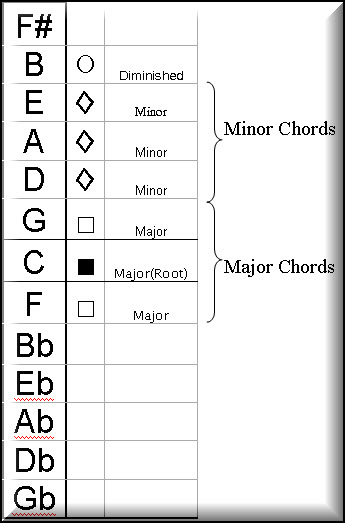Basic Harmonic Movement
<<About SeeChord Chord Structure>>
Basic Harmonic Movement
Most pieces of music involve some kind of harmonic change. It is rare for a piece to be based solely on one chord although this does happen in some minimalist and modern dance music. On the whole a chord sequence will comprise chords that are closely related. In fact it is possible to write a family of chords that can be made out of the notes in a scale. For example, in the key of C major one would mainly use the notes from the C major scale: C D E F G A B C.
If we take 3 alternate notes (triad) starting with C we get a C major chord C E G.
If we take 3 alternate notes starting with D we get a D minor chord D F A
If we take 3 alternate notes starting with E we get a E minor chord E G B
If we take 3 alternate notes starting with F we get a F major chord F A C
If we take 3 alternate notes starting with G we get a G major chord G B D
If we take 3 alternate notes starting with A we get a A minor chord A C E
If we take 3 alternate notes starting with B we get a B diminished chord B D F
These chords form the family of chords that we would largely expect to find in a piece of music that was in the key of C major (for minor keys see the major/minor chapter). We can see the chords on a SeeChord chart:

It is clear from examining the chart that the two most closely related chords to C are F and G. In fact, many songs are composed entirely of these three chords, often notated in roman numerals as I IV and V.
Next we have the three minor chords that arise as a result of constructing chords from a major scale and at the top we have a diminished chord.
It follows that when we examine the chord structure of a piece in C, we would expect to see the major symbols appearing F C and G and the minor symbols appearing on D A and E and the diminished symbol on the B.
We can see also that most of the chords are above C in the chart.
Look at the chart for the start of Bach’s 1st Prelude from book one of the Well Tempered Clavier:
[seeChordViewer src=”/content/Application/basic-harmonic-movement/interpretation1-viewer”]

Here we can see that mostly, the expected symbols occur in the expected places with only one exception in bar 6 where a D7 chord is used instead of D minor.
As pointed out previously, the harmony tends to move down a step at a time (in fifths) and then jump up again. This pattern is very common. In fact we can see this general pattern in almost any piece of western music. Here is the complete chart for the jazz standard, Autumn Leaves:
[seeChordViewer src=”/content/Application/basic-harmonic-movement/basicharmonicmovement2-viewer”]
This is one of my favourite SeeChord charts as it lays bare a pattern that is so common in music. We can see the music falling in fifths with the occasional interruption where it jumps back up again. Fly me to the moon uses the same pattern and countless others use some of it. The pattern you see above will be repeated time and time again across all genres of music. It is this ability to see the way the harmony is moving that makes SeeChord such a powerful analytical tool.